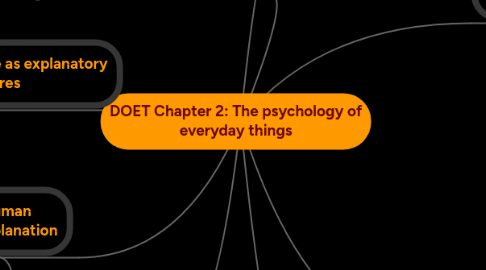
1. People as explanatory creatures
1.1. Mental models
1.1.1. Conceptual models of how...
1.1.1.1. objects work
1.1.1.2. events take place
1.1.1.3. people behave
1.1.2. Based on previous knowledge
1.1.2.1. Real of imaginary
1.1.2.2. naive or sophisticated
1.1.3. If no external information is given
1.1.3.1. Imagination takes in
2. Blaming the wrong cause
2.1. People tend to blame themself
2.1.1. Caused by faulty mental models
3. Helplessness
3.1. Learned
3.1.1. numerous bad experiences
3.2. Taught
3.2.1. badly designed objects
3.2.1.1. faulty mental models
3.2.1.2. poor feedback
3.2.2. vicious cycle
3.2.2.1. Fail at something
3.2.2.2. self-blame = cant do this
3.2.2.3. next time: doesnt even try
4. The nature of human thought and explanation
4.1. Find explanations
4.1.1. IF no: Puzzled or discrepant situation
4.1.2. IF yes: No puzzled or discrepant situation
4.2. explanations, based on previous experience. May not not apply to the current situation.
5. The seven stages of action as design aids
5.1. Visibility
5.2. A good conceptual model
5.3. Good mappings
5.4. Feedback
6. Falsely blaming yourself
6.1. Designers must assume every possible err and design to minimize them
7. The seven stages of action
7.1. Forming the goal
7.2. Forming the intention
7.3. Specifying an action
7.4. Executing the action
7.5. Percieving the state of the world
7.6. Interpreting the state of the world
7.7. Evaluating the outcome
8. The gulfs of execution and evaluation
8.1. relationships between
8.1.1. Mental intention and interpretations
8.1.2. Physical actions and states
8.2. Gulf of execution
8.2.1. Dothe actions provided by the system match those intended by the person?
8.3. Gulf of evaluation
8.3.1. Does the system provide a physical representation that can be diretcly percieved and interpretated in terms of the intention of the person?
